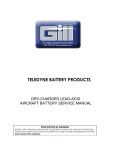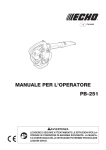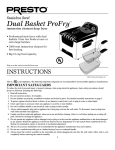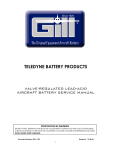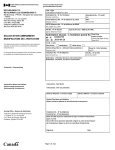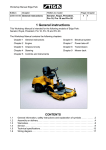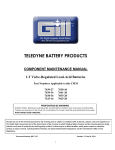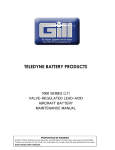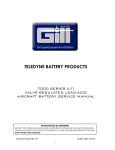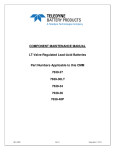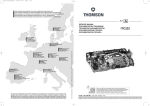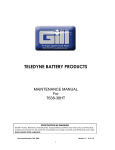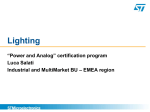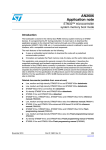Download TELEDYNE BATTERY PRODUCTS
Transcript
TELEDYNE BATTERY PRODUCTS DRY-CHARGED LEAD-ACID AIRCRAFT BATTERY SERVICE MANUAL PROPOSITION 65 WARNING BATTERY POSTS, TERMINALS AND RELATED ACCESSORIES CONTAIN LEAD AND LEAD COMPOUNDS, CHEMICALS KNOWN TO THE STATE OF CALIFORNIA TO CAUSE CANCER AND REPRODUCTIVE HARM. WASH HANDS AFTER HANDLING. Document Number: Q01-1120 Revision B 6-30-05 i Receipt and use of this technical document by any receiving party is subject to compliance with all decrees, statutes, rules and regulations of the United States Government and of the Governments of the countries in which Teledyne Battery Products and the receiving party are doing business at the time of receipt by the receiving party in effect, or which may be in effect hereafter, which govern exports or otherwise pertains to export controls, including without limitation, the Export Administration Regulations and the International Traffic in Arms Regulations. WARNING THE SAFETY INSTRUCTIONS/PRECAUTIONS POSTED IN VARIOUS SECTIONS WITHIN THIS MANUAL MUST BE STRICTLY FOLLOWED. ALWAYS WEAR SAFETY GLASSES AND ACID-RESISTANT GLOVES WHENEVER HANDLING BATTERIES ELECTROLYTE CONTAINS SULFURIC ACID, WHICH CAN PERMANENTLY DAMAGE EYES AND CAUSE SEVERE BURNS TO EXPOSED SKIN. FOR LIMITATIONS, PROCEDURES AND PERFORMANCE INFORMATION NOT CONTAINED IN THIS SUPPLEMENT CONSULT THE BASIC PILOTS OPERATING HANDBOOK, AIRPLANE FLIGHT MANUAL, THE SPECIFIC STC OR THE BATTERY CONTINUOUS AIRWORTHINESS INSTRUCTIONS FOR THE APPLICATION. THIS SERVICE MANUAL SHOULD NOT BE CONSTRUED AS THE FINAL AUTHORITY IN MAINTAINING YOUR SPECIFIC BATTERY. PLEASE CONSULT WITH TELEDYNE TECHNICAL SUPPORT FOR FURTHER INFORMATION. ii Gill SERVICE MANUAL Section CONTENTS Page 1 REVISION PAGE …………………………………………………………… 2 SCOPE …………………………………………………………… 2 3 INTRODUCTION …………………………………………………………… 3 4 DRY-CHARGED LEAD-ACID BATTERIES ………………………... 4 ………………………………………………….. 4 5 6 7 4.1 Description 4.2 Specification Definitions 4.3 Temperature Effects 4.4 …………………………………. 4 …………………………………………. 5 Life Expectancy ………………………………………………….. 6 PREPARING DRY-CHARGED BATTERIES FOR USE ……………….. 8 ………………………………………………….. 8 5.1 Tools Needed 5.2 Filling (or Activation) INSTALLATION …………………………………………. 6.1 Battery Installation Pre-Verification 6.2 Battery Ventilation 6.3 Sump Jar Treatment 6.4 Ventilation System Requirements SERVICING 8 ………………………………………………….. 13 ……………….……….. 13 ………………………………………….. 13 …………………………………. 14 ………….…………….. 14 …………………………………………………………… 15 7.1 Service Requirements …………………………………………. 15 7.2 Connector/Wiring Inspection …………………………………. 15 7.3 Electrolyte Levels …………………………………………. 16 7.4 Sump Jar Maintenance …………………………………………. 17 7.5 Managing Periods of Non-Use ………………………… 18 7.6 Shelf Life and Storage Conditions ………………………… 18 7.7 Continued Airworthiness Determination 7.8 Charging ……………….. 19 ………………………………………………….. 21 7.8.7 Constant-Current (CI) ………………………… 22 7.8.8 Constant-Voltage (CV) ………………………… 23 7.9 Recharging Deeply Discharged Batteries 7.10 Battery Safety Q01-1120 1 Revision B 6-05 ……………….. 24 ………………………………………………….. 25 iii Teledyne Battery Products Gill SERVICE MANUAL Section 8 Page 7.11 Jump Starting an Engine ………………………………………….. 27 RECYCLING ……………………………………………………………. 28 8.1 Material Safety Data Sheets……………………………………… 28 8.2 Recycler Locations ………………………………………………. 28 8.3 International Recycling Resources ………………………… 29 …………………………………………………………………….. 30 9 FAQ’S 10 GLOSSARY 11 TROUBLE SHOOTING 12 APPENDIX A Battery Specifications …………………………. 38 13 APPENDIX B Using a Hydrometer ………………………………….. 58 14 APPENDIX C MSDS ……………………………………………………. 60 15 16 APPENDIX D APPENDIX E Mixing Electrolyte ………………………………… .. Activation and Service Instructions for Gill Dry-Charged Lead-Acid Aircraft 69 Batteries (TBP 1560) 70 Q01-1120 Revision B 6-05 ……………………………………………………………. 33 …………………………………………………… iv 34 ………………………….. Teledyne Battery Products Section 1 Gill DRY-CHARGE MAINTENANCE MANUAL Revision Description of Change Approved By Date NC Completely Revised J. Rajpara 7-15-03 A Added new load tester J. Rajpara 8-31-04 B Corrected manual number J. Rajpara 6-30-05 Premium Aircraft Batteries REVISIONS TELEDYNE BATTERY PRODUCTS www.gillbatteries.com 800.456.0070 Q01-1120 Revision B 6-05 Page 1 of 74 Teledyne Battery Products Section 2 Gill DRY-CHARGE MAINTENANCE MANUAL This manual provides Maintenance Procedures for Gill Dry-Charged Lead Acid Aircraft Batteries manufactured under FAA Parts Manufacturer Approvals (PMA). This manual has been written for the purpose of guidance only; consult Teledyne Battery Products Technical Support for further information. The latest list of our PMA’s can be obtained on our website at: www.gillbatteries.com or by calling our Customer Support at (800) 456 0070. Premium Aircraft Batteries SCOPE TELEDYNE BATTERY PRODUCTS www.gillbatteries.com 800.456.0070 Q01-1120 Revision B 6-05 Page 2 of 74 Teledyne Battery Products Section 3 Gill DRY-CHARGE MAINTENANCE MANUAL Teledyne Battery Products of today had a modest beginning in the early 1920’s under the stewardship of Mr. Lawrence Gill. Since inception, Gill has been producing first rate batteries primarily for the aircraft industry. In the 1960’s, Gill Electric was sold to Teledyne, acquiring the new name of Teledyne Battery Products. Gill has introduced most of the innovations in the industry, including 24 volt batteries for light aircraft and low impedance, high power batteries for the turbine fleet. Meeting the stringent weight requirements, it was a Gill battery that powered the Voyager’s electrical systems and Given our demonstrated ability of building batteries that have predictable characteristics to narrow specifications, we are chosen as original equipment by most airframe manufacturers and are the popular choice for replacement. Many design innovations contribute to the value of a Gill aircraft battery, such as: • • • • • Through-the-partition intercell welding. Enveloped plates. Improved case-cover seal. Heavy-duty internal post. Redesigned cell construction to provide better power delivery and charge acceptance. Whether cranking a piston engine, spooling a demanding jet turbine or high-output applications in business jets, turboprops and helicopters, Teledyne Battery Products has the TELEDYNE BATTERY PRODUCTS avionics on its record-breaking non-stop around-the-world flight. Premium Aircraft Batteries INTRODUCTION right power source for the job! group of companies to continue providing unsurpassed product integration enabling customers’ ease of use and reliability. www.gillbatteries.com Teledyne Battery Products is committed to utilizing/developing synergies within the Teledyne 800.456.0070 Q01-1120 Revision B 6-05 Page 3 of 74 Teledyne Battery Products Section 4 Gill DRY-CHARGE MAINTENANCE MANUAL 4.1 DESCRIPTION 4.1.1 These batteries are assembled with electrodes (plates) that have been fully charged and dried. The dried plates are quite stable over time, allowing the batteries to be stored indefinitely. 4.1.2 Each cell is tightly sealed prior to shipment. These seals must not be tampered with during storage and should only be removed just prior to activation with 4.1.3 It is recommended that these batteries be stored in cool, dry areas, as high humidity and temperature will only serve to discharge the negative plates, requiring considerable conditioning if the oxidation is severe. 4.2 SPECIFICATION DEFINITIONS Gill aircraft batteries are defined by a series of specifications: 4.2.1 The One-Hour Rate This is the rate of discharge a battery can endure for one hour with the battery voltage at or above 1.67 volts per cell, or 20 volts for a 24 volt lead-acid battery, or 10 volts for a 12 volt lead-acid battery. the discharge rate and time (in hours) to the specified end voltage. 4.2.2 The Emergency Rate This is the rate of discharge a battery can endure for thirty minutes with the battery voltage at or above 1.67 volts per cell, or 20 volts for a 24 volt leadacid battery, or 10 volts for a 12 volt lead-acid battery. to support the essential bus for thirty minutes. Q01-1120 Revision B 6-05 Page 4 of 74 Teledyne Battery Products 800.456.0070 The Emergency Rate is the total essential load, measured in amperes, required www.gillbatteries.com The One-Hour Capacity, measured in Ampere Hours or Ah, is the product of TELEDYNE BATTERY PRODUCTS electrolyte. Battery life begins when the electrolyte is added. Premium Aircraft Batteries DRY-CHARGED LEAD-ACID BATTERIES Gill DRY-CHARGE MAINTENANCE MANUAL 4.2.3 State of Charge voltage measurements should be used as a guide only. Note Figure 1, which indicates the relationship between Open-Circuit Voltage (No-Load Voltage, OCV) and % State-of-Charge (SOC) for Dry-Charged Products. Please note that state-of-charge is not the same as available capacity (see GLOSSARY). Figure 1 TELEDYNE BATTERY PRODUCTS Battery Open Circuit Voltage Vs Approximate % State of Charge 24 Volt Dry-Charged Lead-Acid Batteries 26.5 Battery Open Circuit Voltage 26.0 25.5 25.0 24.5 24.0 20% 40% 60% 80% 100% % State of Charge 4.3 TEMPERATURE EFFECTS 4.3.1 External temperatures will alter electrolyte viscosity – in turn affecting the Q01-1120 The freezing point of electrolyte is quite low. However, a discharged battery, with lower specific gravity electrolyte, will tend to freeze at higher Revision B 6-05 Page 5 of 74 Teledyne Battery Products 800.456.0070 current developing characteristics of the battery. Lower temperatures will generally result in reduced power performance. 4.3.2 www.gillbatteries.com 23.5 0% Premium Aircraft Batteries State of Charge is a quick reference to the state of health of a battery. These Gill DRY-CHARGE MAINTENANCE MANUAL temperatures. Note Table 1 for electrolyte freezing points with varying 4.3.3 Charge acceptance at low temperatures (less than 300F) is generally low. It is preferred to charge batteries at higher temperatures (300F to 900F). Table 1 FREEZING POINT OF ELECTROLYTE Freezing Point Specific Gravity 0C 1.285 -85 -65 1.250 -61 -52 1.225 -35 -37 1.200 -17 -27 1.175 -4 -19 1.150 +5 -15 1.125 +13 -10 1.100 +18 -7.7 LIFE EXPECTANCY 4.4.1 Typical battery failure mode should be complete non-reversible utilization of active material. A battery that is operated and maintained per manufacturers guidelines should deliver several years of useful service. 4.4.2 Charging variations 4.4.2.1 Improper voltage settings • Note recommended voltage settings in Table 2. Make sure that the voltage regulators are correctly adjusted. 4.4.2.2 Overcharging • Overcharging could result from leaving a battery on charge too deterioration of the active material and accelerated grid corrosion. Revision B 6-05 Page 6 of 74 Teledyne Battery Products 800.456.0070 long at voltages higher than recommended. This will result in Q01-1120 www.gillbatteries.com However, actual service life varies due to several factors: TELEDYNE BATTERY PRODUCTS 4.4 0F Premium Aircraft Batteries electrolyte strength (sulfuric acid concentration). Gill DRY-CHARGE MAINTENANCE MANUAL 4.4.2.3 Undercharging Chronic undercharging will lead to extensive sulfation and underperformance. These batteries will be difficult to recharge. 4.4.3 4.4.4 High/Very Low temperature operations 4.4.3.1 Higher temperatures (above 1200F) will lead to quicker grid and 4.4.3.2 Very low temperature (below -100F) operations could lead to active material deterioration. chronically undercharged batteries Improper electrolyte level adjustments Adding contaminated water/other liquids • Electrolyte must be free from organics, chlorides and metals. These impurities will affect performance significantly. 4.4.4.2 Using a battery with low levels of electrolyte • A battery operated with low levels of electrolyte will only use the submerged portions of the battery plates, causing irreversible damage to the exposed portion of the plates. 4.4.4.3 Adding too much water in some cells • These cells will have electrolyte that could be considerably diluted, affecting the essential chemical balance in the cell, causing decrease in performance. Table 2 RECOMMENDED VOLTAGE REGULATOR SETTINGS Operating (0F) Minimum Nominal 24 Volt Battery Maximum Minimum Nominal Maximum 120 13.35 13.75 13.95 27.1 27.5 27.8 90 13.6 14.0 14.2 27.6 28.0 28.3 60 13.85 14.25 14.45 28.1 28.5 28.8 30 14.1 14.5 14.7 28.6 29.0 29.3 <0 14.35 14.75 14.95 29.1 29.5 29.8 PREPARING DRY-CHARGED BATTERIES FOR USE Q01-1120 Revision B 6-05 Page 7 of 74 Teledyne Battery Products Section 5 800.456.0070 CONTINUOUS OPERATION ABOVE 1200F IS NOT RECOMMENDED www.gillbatteries.com Temperature 12 Volt Battery TELEDYNE BATTERY PRODUCTS 4.4.4.1 Premium Aircraft Batteries • Gill DRY-CHARGE MAINTENANCE MANUAL TOOLS NEEDED a) Hydrometer (To read 1.110 to 1.300), with zero at 800F. b) 800F Correction Thermometer; a thermometer capable of reading up to 1500F may also be used. c) Constant-Current Charger. d) Wax-coated funnel (provided); a plastic (non-nylon) funnel may also be used. 5.2 FILLING (OR ACTIVATION) Always use the electrolyte that is supplied with the batteries. For design performance, do not use electrolyte with specific gravities other than those specified. 5.2.2 Please refer to Activation and Service Instructions for Gill Dry-Charged Lead- 5.2.3 If electrolyte is not available, refer to Appendix D for preparation of electrolyte Acid Aircraft Batteries, TBP 1560, latest revision provided with your battery. from concentrated acid. WARNING Electrolyte contains sulfuric acid which is highly corrosive and can cause severe burns to exposed skin and permanent damage to eyes. Avoid spilling or splashing. Wear rubber gloves and safety goggles whenever you are handling electrolyte or examining batteries TELEDYNE BATTERY PRODUCTS 5.2.1 Premium Aircraft Batteries 5.1 during charging. The activation process: a) Inspect the battery for any shipping damage prior to filling. b) Permanently mark the activation date (Month and Year) on the battery, making sure that the battery is not damaged while doing so. d) Make sure you have enough electrolyte – refer to Table 3. Q01-1120 Revision B 6-05 Page 8 of 74 Teledyne Battery Products 800.456.0070 c) Remove storage caps. www.gillbatteries.com 5.2.4 Gill DRY-CHARGE MAINTENANCE MANUAL e) Gently shake the electrolyte bottles before removing the cap to ensure CAUTION When adding electrolyte to dry charged batteries, ensure cleanliness at all times. Electrolyte contains about 40% sulfuric acid and is very corrosive. Metals, chlorides or organic impurities in electrolyte will definitely impair performance. Avoid contaminating the electrolyte. Any plastic container except nylon may be used to contain the electrolyte. f) Carefully add electrolyte through the wax-coated funnel (provided) or a of the separators WARNING Wear safety goggles when looking into the cells and acid resistant gloves when handling batteries. Electrolyte contains sulfuric acid, which is highly corrosive and can cause severe burns to exposed skin and permanent damage to eyes. g) Install the vent caps with a quarter turn and let the battery sit for approximately 30 minutes (soak time) – gently rock the battery a few times to allow the entrapped air to escape. h) The battery may heat up due to the reactions going on in the cells, occasionally causing the electrolyte to react vigorously. Please ensure vent TELEDYNE BATTERY PRODUCTS plastic (non-nylon) funnel – to prevent spillage, filling each cell to the top Premium Aircraft Batteries electrolyte is thoroughly mixed. caps are placed on correctly. Use external cooling (fan) if needed. After the soak time, check each cell for electrolyte levels. Add electrolyte to j) Connect the charging cables and begin charging using our recommended the top of the separators. DO NOT ADD ANY WATER AT THIS TIME. methods (Refer to Initial Charging Rates in Table 4). www.gillbatteries.com i) k) After the first hour of charge, check the electrolyte level in each cell. Make ONLY. l) Q01-1120 Replace vent caps finger tight, to ensure electrolyte does not leak. Revision B 6-05 Page 9 of 74 Teledyne Battery Products 800.456.0070 sure that the level is just to the bottom of the split ring. USE ELECTROLYTE Gill DRY-CHARGE MAINTENANCE MANUAL m) Make sure that battery temperature does not exceed 1150F. Reduce the n) Completion of charge is indicated by a stable specific gravity reading of 1.275 to 1.295 (temperature compensated as described in Appendix B) taken in three readings over three hours, as described in paragraph 5.2.5, Initial Charging Instructions. Use recommended hydrometer. A stable on-charge voltage reading may also be used. The battery should typically be charged in about 8-12 hours using a constant current charger. p) After the battery is fully charged, adjust the level of the electrolyte to the bottom of the split ring (bottom of vent well) with the charger still on. Table 3 ELECTROLYTE VOLUMES Gill Part Number Former Part Number Fill Gill Part Volume Former Part Number (Quarts) Number Fill Volume (Quarts) PS6-9 2 G-247 PS12-24P11M 4 G-35 PS6-11 3 GE-50E MS18045-42 8 G-35M ------ 3 GE-50C AN3150 8 G-88 6GAA-13 8 GE-51E MS18045-41 5 G-240 PS12-9 3 GE-51C AN3151 5 G-241 PS12-9M 3 GE-54C AN3154 3 G-242 PS12-11 3 G-638E/C BB638/T-E 9 G-243 PS12-11M 3 G-6381E/C BB638/T1-E 9 G-244 PS12-24P9 4 G-639E/C BB639/T-E 5 G-245 PS12-24P9M 4 G-640E BB640/T-E 3 G-246 PS12-24P11 4 G-641 G-41 4 INITIAL CHARGING INSTRUCTIONS a) Replace vent caps tightly and start charging per recommendations for your battery type. Note Table 4 for Initial Charge Rates. Q01-1120 Revision B 6-05 Page 10 of 74 Teledyne Battery Products 800.456.0070 5.2.5 www.gillbatteries.com G-25 TELEDYNE BATTERY PRODUCTS o) At the end of charge, all cells should be gassing (bubbling) uniformly. Premium Aircraft Batteries charge rate or use external cooling if it does. Gill DRY-CHARGE MAINTENANCE MANUAL b) Do not allow the battery to stand for more than 8 hours, after the c) After the first hour of charge, check the electrolyte levels in each cell. Make sure that the level is just to the bottom of the split ring. Use hydrometer to remove excess. If the electrolyte levels are low, ADD ELECTROLYTE ONLY. DO NOT ADD WATER AT THIS STAGE. WARNING Wear safety goggles when looking into the cells and acid resistant gloves when handling batteries. Electrolyte contains sulfuric acid, which is highly corrosive and can cause severe burns e) Maintain temperature of the battery around 750F to 1100F. If it gets hotter, reduce the charging rates and increase the charge time proportionally. Note: The charge time can be adjusted proportionally to compensate for chargers that may not be capable of delivering the recommended rate. f) It will take 8 to 12 hours to fully charge the battery using a constant current charger. g) The best indicator of full charge is a stable specific gravity reading. Using the recommended hydrometer, take three readings at approximately equal time intervals over three hours. When fully charged, the specific gravity should be greater than 1.275. Make sure that the readings are temperature compensated as described in Appendix B. Appendix B has appropriate measurement techniques using a hydrometer. TELEDYNE BATTERY PRODUCTS to exposed skin and permanent totightly eyes. then clean up any spilled electrolyte. d) Replace the damage vent caps Premium Aircraft Batteries electrolyte has been added, before you begin to charge. Please call Teledyne Battery Products if there are any further questions. as an indicator. ON-CHARGE battery voltages will stabilize around 32 volts when charging at constant current for 24 volt batteries or 16 volts for 12 volt batteries. i) At the end of charge, all cells will be gassing freely and the battery voltage will stabilize and start to drop slightly. www.gillbatteries.com h) If it is not possible to measure specific gravity, battery voltage may be used WARNING exposed skin and permanent damage to eyes. Avoid spilling or splashing. Wear rubber gloves and safety goggles whenever you are handling electrolyte or examining batteries during charging. Q01-1120 Revision B 6-05 Page 11 of 74 Teledyne Battery Products 800.456.0070 Electrolyte contains sulfuric acid which is highly corrosive and can cause severe burns to Gill DRY-CHARGE MAINTENANCE MANUAL j) Once the battery has been charged and all cables disconnected, clean on tight – otherwise the solution of baking soda will enter the cells and partly neutralize the electrolyte – then clean the battery with water and baking soda. Wipe dry before installation. Table 4 INITIAL CHARGE RATES Gill Part Number Number Initial Charge Current (A) Final Charge Current (A) 3 1.5 G-35 PS6-11 3 1.5 G-35M ------- 3 1.5 G-88 6GAA-13 6 3 G-240 PS12-9 2 1 G-241 PS12-9M 2 1 G-242 PS12-11 3 1.5 G-243 PS12-11M 3 1.5 G-244 PS12-24P9 3 1.5 G-245 PS12-24P9M 3 1.5 G-246 PS12-24P11 3 1.5 G-247 PS12-24P11M 3 1.5 GE-50E MS18045-42 3 1.5 GE-50C AN3150 3 1.5 GE-51E MS18045-41 3 1.5 GE-54C AN3154 2 1 GE-51C AN3151 3 1.5 G-638E BB638/T-E 3.5 2.5 G-6381E BB638/T1-E 3.5 2.5 G-639E BB639/T-E 3 1.5 G-640E BB640/T-E 3 1.5 G-641 G-41 3 1.5 Revision B 6-05 Page 12 of 74 Teledyne Battery Products 800.456.0070 PS6-9 www.gillbatteries.com G-25 TELEDYNE BATTERY PRODUCTS Q01-1120 Former Part Premium Aircraft Batteries residual electrolyte on the battery as follows: Make sure the vent caps are Section 6 Gill DRY-CHARGE MAINTENANCE MANUAL INSTALLATION When installing or removing a battery, take special care to ensure that no sparks are created by tools, and that the terminals are not shorted out by tools or loose jewelry. ALWAYS REMOVE THE GROUND CABLE FIRST AND INSTALL IT LAST. IF POSSIBLE, ATTACH THE GROUND CABLE TO THE FRAME OF THE BATTERY COMPARTMENT. Do not lift the battery by their vent tubes, receptacles or terminals. 6.1 BATTERY INSTALLATION PRE-VERIFICATION If the original equipment battery is of another type or manufacture, the Teledyne Gill Type Certificated installation kit. WARNING The battery compartment must be coated with an acid resistant material to prevent corrosion due to accidental spills of electrolyte. If possible, the spilled electrolyte must be drained away from or contained such that it does not come into contact with the aircraft systems or structure. WARNING BATTERIES MUST NOT BE LOCATED IN ENGINE COMPARTMENTS UNLESS ADEQUATE MEASURES ARE TAKEN TO GUARD AGAINST POSSIBLE FIRE HAZARDS, DELETERIOUS EFFECTS TELEDYNE BATTERY PRODUCTS replacement should be accomplished with the proper FAA Approved Supplemental Premium Aircraft Batteries WARNING OF HIGH TEMPERATURE ON BATTERIES AND PROVISION FOR ADEQUATE VENTILATION WARNING Aircraft must be equipped with a leak proof battery ventilation system. The system provides for the removal of gases and acid fumes from the airplane in order to reduce fire hazard and to eliminate corrosion of metal parts due to acid. 6.2 www.gillbatteries.com AROUND THE BATTERY. BATTERY VENTILATION so air can flow over the top of the battery and through a sump jar, where the fumes are neutralized by a sodium bicarbonate solution or dry sodium bicarbonate. Q01-1120 Revision B 6-05 Page 13 of 74 Teledyne Battery Products 800.456.0070 Some Teledyne Gill batteries are designed with cover manifold vents (single or double) Gill DRY-CHARGE MAINTENANCE MANUAL 6.3 SUMP JAR TREATMENT Teledyne Gill battery distributor. The jar should contain a ½” thick pad saturated with a 5% solution of sodium bicarbonate in water or about ³⁄₈” of dry sodium bicarbonate. The tube carrying fumes to the sump extends into the jar about 1” from the lid. See Figure 2 for basic ventilation outline. 6.4 VENTILATION SYSTEM REQUIREMENTS An overboard discharge tube leads from the top of the jar to a point outside the aircraft. The tube is designed so there is air flow from the inlet venting out of the plane (with negative pressure at inlet) whenever the aircraft is in flight. This helps to outside the aircraft. See FAA AC 43.13-1B, Chapter 11, Section 2, Battery Ventilating Systems. Figure 2 Battery Ventilation System TELEDYNE BATTERY PRODUCTS ensure a continuous flow of air across the top of the battery, through the sump and Premium Aircraft Batteries The sump jar has a capacity of approximately one pint and is available through your www.gillbatteries.com 800.456.0070 Q01-1120 Revision B 6-05 Page 14 of 74 Teledyne Battery Products Section 7 Gill DRY-CHARGE MAINTENANCE MANUAL SERVICING SERVICE REQUIREMENTS 7.1.1 Proper maintenance is essential if the battery is to achieve maximum life and performance. To assure these goals, periodic inspection in the aircraft is necessary. Please review Activation and Service Instructions for Gill DryCharged Lead-Acid Aircraft Batteries, TBP 1560, latest revision. 7.1.2 The battery must be inspected and serviced at 800 ±50 flight hours or 11 ± 1 calendar months after initial installation, whichever occurs first. Thereafter, the 1 calendar months, whichever occurs first, unless the hours per flight are significantly reduced (less than one hour) such that the battery cannot be adequately charged on-board. 7.1.3 For continuing limited (less than one hour) flying, the battery should be removed from the aircraft at least once a month for top-off charging. The Constant Voltage charging method described in the Activation and Service Instructions must be used. 7.1.4 7.2 The use of separate lead-acid and nickel-cadmium battery storage facilities are recommended to prevent electrolyte contamination. TELEDYNE BATTERY PRODUCTS battery must be inspected and serviced once every 400 ± 25 flight hours or 6 ± Premium Aircraft Batteries 7.1 CONNECTOR/WIRING INSPECTION If the aircraft is equipped with a battery quick disconnect, the mechanical integrity of the plug(s) must be checked for fit on the attaching screw to receptacle bayonet pins. The resiliency of the female mating surfaces to the battery receptacle terminals must also be checked. 7.2.2 Early discovery of defective connectors as well as battery receptacles is extremely important to prevent failure or possible fire hazard. a) Excessively loose handle and locking assembly. b) Pitted or corroded mating surfaces. Revision B 6-05 Page 15 of 74 Teledyne Battery Products 800.456.0070 Check for the following: Q01-1120 www.gillbatteries.com 7.2.1 Gill DRY-CHARGE MAINTENANCE MANUAL c) Burn marks caused when battery is disconnected under load. the larger diameter probe of the tool, TBP 3600-51 Rev A (GO-NOGO Gauge), into each helix or sleeve to maximum depth. The fit should be snug and require a removal force greater than one pound. e) To be assured that the contact is adequate for a worn battery pin, insert the small diameter end of the tool. This must also provide a snug fit, with a nominal removal force greater than one pound. Replace the connector if it shows excessive wear or fails to meet the fit test. f) Battery contact pin must be inspected for corrosion, pitting or burn marks. g) If the cleaning process reduces the pin diameter below 0.370”, the battery must be replaced. 7.2.3 In addition to inspecting the connector, condition and type of wiring must be examined. Excessive corrosion and use of aluminum wire can be detrimental to safe operation. Please clean/replace wiring. Replacement wiring kits are available from the aircraft manufacturer. 7.3 ELECTROLYTE LEVELS 7.3.1 Electrolyte levels must be maintained just over the plates at all times. Lower levels will damage the battery. Replenish electrolyte with clean water TELEDYNE BATTERY PRODUCTS If any of these defects exist, the surfaces should be cleaned. Premium Aircraft Batteries d) To test for the resiliency of the mating surfaces to an oversized pin, insert (preferably distilled), and NOT electrolyte, unless electrolyte has been The frequency of water additions will depend on: a) Battery duty cycle b) Battery operating temperature c) Generator voltage regulator setting d) Flight hours Charge the battery when water is added. This will mix the electrolyte and water to provide a homogeneous electrolyte. Continue charging until the voltage and specific gravity readings are constant over three readings taken over three hours at approximately equal intervals. Q01-1120 Revision B 6-05 Page 16 of 74 Teledyne Battery Products 800.456.0070 7.3.2 www.gillbatteries.com inadvertently spilled from the battery. Gill DRY-CHARGE MAINTENANCE MANUAL Electrolyte contains sulfuric acid which is highly corrosive and can cause severe burns to exposed skin and permanent damage to eyes. Avoid spilling or splashing. Wear rubber gloves and safety goggles whenever you are handling electrolyte or examining batteries during charging. 7.3.3 Adjust electrolyte level (just below the vent well) at the end of the charge, with the use of a hydrometer. Remember, the electrolyte will heat-up and expand as the battery is being charged. Check the battery electrolyte level and the sump jar on a routine basis (every 7.3.5 Formation of whitish-green deposits around terminals indicates a leakage of 100 flight hours). Do not allow the cells to run dry or be too full of electrolyte. electrolyte. Make sure that all vent caps are tight, clean the deposits with a wire brush and carefully neutralize the terminals with a 5% solution of sodium bicarbonate in water. WARNING Electrolyte contains sulfuric acid which is highly corrosive and can cause severe burns to exposed skin and permanent damage to eyes. Avoid spilling or splashing. Wear rubber gloves and safety goggles whenever you are handling electrolyte. 7.3.6 The surface of the battery should be wiped clean and kept this way. A film of the battery to discharge. If the electrolyte is heavily discolored (brown or black), it represents an aged battery or one that has been subjected to severe vibration or overcharge. Replace the battery. 7.4 www.gillbatteries.com electrolyte over the top of the battery may bridge across the terminals causing 7.3.7 TELEDYNE BATTERY PRODUCTS 7.3.4 Premium Aircraft Batteries WARNING SUMP JAR MAINTENANCE Q01-1120 Inspect the electrolyte levels and the sump jar at the specified battery maintenance intervals (noted in 7.3.4). Revision B 6-05 Page 17 of 74 Teledyne Battery Products 800.456.0070 7.4.1 Gill DRY-CHARGE MAINTENANCE MANUAL 7.4.2 If there is any flow of electrolyte in the sump jar, clean as follows: b) c) 7.4.3 Wear goggles and rubber gloves. Slowly add sodium bicarbonate to the residual acid in the sump jar until the reaction subsides (shake jar side to side, slowly). Wash jar and pad thoroughly. Once the jar has been cleaned, recharge it with fresh sodium bicarbonate as follows: a) b) 7.5 Saturate a new pad with a 5% solution of sodium bicarbonate and place pad over the sodium bicarbonate in the jar. Install jar to lid; hand tighten (be sure gasket is in place). MANAGING PERIODS OF NON-USE 7.5.1 Periodically, users will find that they have to curtail flying for any number of reasons. During these times, the batteries have to be correctly maintained for continued service. 7.5.2 Teledyne Battery Products recommends that the battery be removed from the plane during such non-use and either kept on trickle charge (13.5V to 13.8V for 12V batteries, or 27V to 27.6V for 24V batteries); recharged every 90 days or recharged prior to flight. The recharge should be in accordance with Teledyne Battery Products’ Activation and Service Instructions (TBP 1560). SHELF LIFE AND STORAGE CONDITIONS 7.6.1 Once activated with electrolyte, the battery is constantly undergoing parasitic discharging which vary with types of battery chemistries. Note Figure 3, Shelf Life of Flooded Products. 7.6.2 A battery should not be allowed to remain in a discharged condition for any appreciable period of time. If the battery is kept in such a state, the active www.gillbatteries.com 7.6 TELEDYNE BATTERY PRODUCTS c) Add about ³⁄₈” of dry sodium bicarbonate in the jar. Premium Aircraft Batteries a) material will gradually discharge and convert to lead sulfate and, over time, For every 180F increase in temperature, the discharge rate will double! If the battery is 8.9.2 Storage temperature and external loads during parked conditions can play a severely discharged (typically down to ~1.9V/cell), it will sustain permanent damage! significant role in determining the health of a battery. Q01-1120 Revision B 6-05 Page 18 of 74 Teledyne Battery Products 800.456.0070 become very difficult to convert to the original active material. Gill DRY-CHARGE MAINTENANCE MANUAL 7.6.3 A simple example to illustrate the magnitude of a parasitic drain over time: And non-use period is: Total discharge 0.1A 3 weeks = 0.1A x 3 weeks x 24 hours/day x 7 days/week = 50.4 Ah Comparing this loss to the capacity of the battery, this small drain can be quite significant over time! Figure 3 TELEDYNE BATTERY PRODUCTS Shelf Life 24V Dry-Charged Lead-Acid Batteries 26.2 0 Tested at 77 F Battery Open Circuit Voltage 26.0 25.8 25.6 25.4 25.2 24.8 0 20 40 60 80 100 120 140 Shelf Life, Days www.gillbatteries.com 25.0 7.7 Premium Aircraft Batteries If the external load is: CONTINUED AIRWORTHINESS DETERMINATION FOR GILL AIRCRAFT BATTERIES To ensure continued airworthiness the battery should be removed and capacity tested. The recommended service period should initially be at 800 ± 50 hours or 11 ± 1 calendar month(s) whichever comes first. After the initial service, the Q01-1120 Revision B 6-05 Page 19 of 74 Teledyne Battery Products 800.456.0070 7.7.1 Gill DRY-CHARGE MAINTENANCE MANUAL next check should be at 400 ± 25 flight hours or 6 ± 1 calendar month(s), a) Check for proper battery installation per STC Installation Instructions when performing annual and 100 hour inspections and when replacing battery after capacity test. b) Remove the battery from the aircraft and charge it according to Teledyne Battery Products’ recommended charging instructions. Allow the battery to stand on open circuit for one hour. Connect the fully charged battery to a capacity tester that incorporates a d) Discharge the battery at the 30-minute capacity rate to 1.67 volts per cell load resistance, amp meter, volt meter and a timer. (10 volts for a 12 volt battery and 20 volts for a 24 volt battery). Record the discharge time. Note: There may be occasions when it will not be possible to conduct the discharge according to the rates required. Teledyne Battery Products can provide the appropriate discharge curve for such occasions and suggest alternative rates. Please call the Technical Service department for additional instructions, or review the discharge curves for the appropriate battery in Appendix A. e) The battery is considered airworthy if it meets 80% of the 30-minute TELEDYNE BATTERY PRODUCTS c) Premium Aircraft Batteries whichever comes first. The capacity test shall be performed as follows: emergency capacity rating (24 minutes to the cut-off voltage). If the battery fails to meet the minimum run-time, recharge using the constant current method until the specific gravity reading stabilizes over three consecutive readings. Allow the battery to stand on open circuit for one hour. WARNING www.gillbatteries.com f) Electrolyte contains sulfuric acid which is highly corrosive and can cause severe burns to gloves and safety goggles whenever you are handling electrolyte. Q01-1120 Revision B 6-05 Page 20 of 74 Teledyne Battery Products 800.456.0070 exposed skin and permanent damage to eyes. Avoid spilling or splashing. Wear rubber Gill DRY-CHARGE MAINTENANCE MANUAL g) Repeat the discharge test as indicated. If the failure persists, replace the h) If the battery is found to be airworthy, it must be recharged prior to reinstalling it in the aircraft. 7.7.2 The airworthiness limitations section (noted in 7.7.1) is FAA approved and specifies maintenance required under Sections 43.16 and 91.403 of the Federal Aviations Regulations unless an alternative program has been FAA approved. 7.7.3 case they are required for warranty adjustments. CHARGING 7.8.1 Charging must be conducted in a well-ventilated area at ambient conditions ranging from 650F to 800F. Please review charging method (constant-current or constant-voltage) before commencing. The preferred method is constantvoltage. WARNING If the battery room is air-conditioned as part of a general building-wide air conditioning system, the exhaust air from the battery room should not be returned to the air distribution system. The room should have its own exhaust system that vents directly TELEDYNE BATTERY PRODUCTS 7.8 Proper installation, charging and other maintenance records must be kept, in Premium Aircraft Batteries battery. outdoors. sure that there are no sources of sparks in the battery room. 7.8.2 Personal safety is of prime importance. Follow manufacturer’s instruction at all times. Note the safety precautions at the end of this section. THE NATIONAL ELECTRIC CODE FORBIDS CHARGING BATTERIES INSTALLED IN AIRCRAFT OR WITHIN 10 FEET OF FUEL TANK AREAS. Q01-1120 Revision B 6-05 Page 21 of 74 Teledyne Battery Products 800.456.0070 WARNING www.gillbatteries.com Sufficient ventilation should be provided to prevent hydrogen gas build-up. Please make Gill DRY-CHARGE MAINTENANCE MANUAL 7.8.3 Correct charging is very important and will affect the overall life of the battery. resistance and will typically be 10% to 20% higher than the amount of capacity removed during discharge. 7.8.4 Undercharging a battery occurs when the required 105% to 115% of the removed capacity is not returned during recharge. If this were to occur repeatedly, residual lead sulfate will eventually increase in the plates, making it very difficult to recover the battery. In this case the battery will suffer a permanent loss of capacity. Overcharging generally occurs when constant current charging is used without adequate controls. This is the main reason for the preference of constant voltage charging over constant current. Overcharging a battery will corrode the positive grids and break the water component, in the electrolyte, down to hydrogen and oxygen (electrolysis). 7.8.6 Prolonged overcharging will lead to loss of water from the electrolyte and grid 7.8.7 CONSTANT-CURRENT (CI) corrosion. 7.8.7.1 These chargers must be capable of providing an output of ~ 35 volts and ~ 8 amperes (with selector switch) and provide a timer that can terminate charging when the charge is completed. The ampere hours of energy restored is the product of rate of 7.8.7.3 Since these chargers are designed to provide a constant current charge (in amperes) and the time (in hours). throughout the charging period, this method could lead to overcharging if not controlled. In order to control the charge input, these chargers must have a shut-off timer. battery) or 16.5 volts (for a 12 volt battery) as the battery approaches full charge. As long as the charger timing is adequately controlled, this charging regime will not damage the battery. Q01-1120 Revision B 6-05 Page 22 of 74 Teledyne Battery Products 800.456.0070 On-charge voltage could go as high as 33 volts (for a 24 volt www.gillbatteries.com 7.8.7.2 TELEDYNE BATTERY PRODUCTS 7.8.5 Premium Aircraft Batteries The charging process is not 100% efficient due to losses resulting from internal Gill DRY-CHARGE MAINTENANCE MANUAL Electrolyte contains sulfuric acid which is highly corrosive and can cause severe burns to exposed skin and permanent damage to eyes. Avoid spilling or splashing. Wear rubber gloves and safety goggles whenever you are handling electrolyte. 7.8.7.4 Electrolyte specific gravity should be measured and constant over three consecutive readings (see 5.2.5 (g)) or a stable battery voltage (battery voltage should be the same as the charger output voltage over three hours) could be used. Avoid prolonged charging at this voltage. It is preferred to use low rates (0.5 - 5 amps) when charging batteries using this technique, in order to reduce heat and minimize corrosion. Note example under “Recharging Deeply Discharged Batteries” for general outline on using constant current recharge. 7.8.7.6 7.8.8 Review Figure 4 for a basic charging profile of charge current and battery voltage. CONSTANT-VOLTAGE (CV) 7.8.8.1 These chargers are generally designed to provide a constant voltage source, with selectable initial current rates. Model variants may provide selectable charge voltage. Higher output current will reduce recharge time. The current in any circuit is directly proportional to voltage gradient in that circuit (Ohm’s Law). Using CV charging will result in a high initial charging current which will start dropping off when the voltage gradient between the charger and battery begins to decrease. 7.8.8.3 Typically, the charger will regulate to 28.4 volts (24 volt batteries) or 14.2 volts (12 volt batteries). As the battery approaches the charger Please call Gill Technical Support for any additional concerns with charging (see Fig. 4 for typical charge profile). Revision B 6-05 Page 23 of 74 Teledyne Battery Products 800.456.0070 output voltage, charge current will drop below 1 ampere. Q01-1120 www.gillbatteries.com 7.8.8.2 TELEDYNE BATTERY PRODUCTS 7.8.7.5 Premium Aircraft Batteries WARNING Gill DRY-CHARGE MAINTENANCE MANUAL Figure 4 Premium Aircraft Batteries V-I Plot Standard Charging for a FULLY DISCHARGED BATTERY (TO 1.75Volts per Cell, OR 21V) 120 40 Constant Voltage Charging at 28.25V Charge Rate at Constant 75 Amps 35 100 80 Constant Voltage Plateau (28.25V) 20 0 20 Charge -20 Discharge 15 NOTE HOW THE CHARGE RATE DROPS OFF ONCE THE SET VOLTAGE IS REACHED. IN CONSTANT CURRENT MODE, THIS VOLTAGE WOULD BE AS HIGH AS ~ 33V 10 -40 -60 Time 7.9 RECHARGING DEEPLY DISCHARGED BATTERIES 7.9.1 Deep discharge is usually indicated by a battery voltage of less than 10 volts (12 volt battery) or 20 volts (24 volt battery). There is a possibility of recovering TELEDYNE BATTERY PRODUCTS Voltage 40 Charge Rate (A) Battery Voltage 25 Current 60 30 these batteries using constant-current charging techniques, provided they have around 300F to 800F, in which case, the batteries should be replaced. 7.9.2 The battery must be charged at a rate of 1.0A for a total input (in ampere- hours) up to 200% of the one-hour capacity, which is determined as follows: e.g. for a one-hour capacity of 20 Ah, the time is determined to be: At the charge rate of 1.0 amperes, the total time would be: 40 Ah/1.0A = 40 hours Q01-1120 Revision B 6-05 Page 24 of 74 Teledyne Battery Products 800.456.0070 2 x 20 Ah = 40 Ah (Ampere-hours) needed www.gillbatteries.com not been in the deep-discharge state for more than 15 days at temperatures Gill DRY-CHARGE MAINTENANCE MANUAL 7.9.3 Stable voltage, measured 4 hours after charge termination, should be over resumed using guidelines in 6.4.3. 7.9.4 7.10 Avoid subjecting a battery to frequent deep discharge, as this could affect the useful life of the battery. BATTERY SAFETY 7.10.1 Handling Battery Electrolyte WHEN WORKING WITH ELECTROLYTE, ALWAYS WEAR SAFETY GOGGLES AND PROTECTIVE GLOVES AND CLOTHING. USE EXTREME CARE TO AVOID SPILLING OR SPLASHING ELECTROLYTE (~40% SULFURIC ACID) AS IT IS VERY CORROSIVE AND WILL DESTROY CLOTHING, BURN SKIN AND PERMANENTLY DAMAGE EYES. a) When handling plastic-cased batteries, do not exert pressure on the end walls as this could cause the electrolyte to spill out of the vent caps. Use the battery lifting strap or with hands placed at opposite corners. Electrolyte can be stored indefinitely. BEFORE opening and using the electrolyte, shake the container gently. EMERGENCY PROCEDURE FOR EXPOSURE TO ELECTROLYTE tap water or if it spilled out, neutralize it with sodium bicarbonate solution followed by a clean water rinse. Electrolyte splashed into eyes is extremely hazardous. If this should happen, force the eye open and flush it with cool, clean water for about five minutes or longer if irritation persists. A doctor should be called immediately and appropriate medical care should be www.gillbatteries.com If electrolyte is splashed on the body, wash it off immediately using large amounts of cool TELEDYNE BATTERY PRODUCTS WARNING Premium Aircraft Batteries 26.3V for 24V batteries and 13.1V for 12V batteries. If not, charging should be applied. Do not add any eye drops or other medication unless told to do so by the doctor. of magnesia, beaten egg whites or vegetable oil. See a doctor immediately. Q01-1120 Revision B 6-05 Page 25 of 74 Teledyne Battery Products 800.456.0070 If electrolyte is taken internally, drink large quantities of water or milk, followed with milk Gill DRY-CHARGE MAINTENANCE MANUAL 7.10.2 Maintain a safe charging area. WARNING ALWAYS WEAR EYE PROTECTION WHEN WORKING WITH BATTERIES. ELECTROLYTE CAN DAMAGE EYES PERMANENTLY a) You must be well aware of applicable OSHA guidelines for safety precautions (note MSDS in Appendix C). b) Keep sparks, flames, burning cigarettes or other ignition sources away at all times. Batteries generate explosive gases and must be handled with care. c) Always use insulated tools. d) Leave vent caps on while charging, removing them only when verifying electrolyte levels or checking for gassing. This will prevent cells from “bridging” (temporary shorting out between the cells) because electrolyte could well out of the cells if left open. e) Follow charger manufacturer’s instructions. f) Do not allow any untrained personnel to work on batteries. g) Do not “break” live circuits at the terminals of a battery because sparks TELEDYNE BATTERY PRODUCTS WARNING Premium Aircraft Batteries Always follow these safety precautions when handling batteries: will occur at the terminals. connection can cause localized heating leading to terminal damage/melting or possible arcing. i) Make sure the room is well ventilated and isolated from the main air- conditioning system. Gases from batteries are explosive and corrosive (due to entrained sulfuric acid in the gases) and must not be allowed to www.gillbatteries.com h) Make certain the charger cables are clean and not frayed. A poor blend in with the main system. ALWAYS TURN THE CHARGER OFF BEFORE DISCONNECTING THE BATTERY. k) Do not touch charger leads while the battery is on charge. Q01-1120 Revision B 6-05 Page 26 of 74 Teledyne Battery Products 800.456.0070 j) Gill DRY-CHARGE MAINTENANCE MANUAL 7.11 JUMP STARTING AN ENGINE cranking power has been diminished must NOT be jumped with another power source. The discharged battery may not be airworthy because it does not have the necessary capacity required to operate the aircraft avionics and electrical system in the event of generator failure. Premium Aircraft Batteries 7.11.1 Teledyne Gill batteries that have been discharged to the point where their TELEDYNE BATTERY PRODUCTS www.gillbatteries.com 800.456.0070 Q01-1120 Revision B 6-05 Page 27 of 74 Teledyne Battery Products Section 8 Gill DRY-CHARGE MAINTENANCE MANUAL RECYCLING BATTERIES MATERIAL SAFETY DATA SHEETS 8.1.1 These have been included in Appendix C. They can be downloaded as needed from the Gill website: www.gillbatteries.com 8.2 RECYCLER LOCATIONS 8.2.1 All parts of spent lead-acid batteries are recyclable. Generally, batteries are collected by retailers and wholesalers who send large quantities to battery treatment recycling facilities. If you have just a few batteries you should contact your local battery retailers or wholesalers. 8.2.2 The following is a listing of recyclers in California: GNB, Inc. Resource Recycling Division 2700 South Indiana Street Los Angeles, CA 90023 (213) 262-1101 RSR Quemetco, Inc. 720 South 7th Avenue TELEDYNE BATTERY PRODUCTS recyclers for reclamation. Battery recyclers are permitted hazardous waste Premium Aircraft Batteries 8.1 City of Industry, CA 91745 8.2.3 The California Department of Toxic Substances Control publishes an annual listing of commercial hazardous waste recyclers, which also includes facilities outside of California. A copy of this publication, the "Directory of Industrial Recyclers" may be obtained by calling (916) 324-2423, or writing to the: California Waste Exchange Resource Recovery Unit www.gillbatteries.com (800)527-9452 Hazardous Waste Management Program 800.456.0070 Department of Toxic Substances Control P.O. Box 806 Sacramento, CA 95812-0806 Q01-1120 Revision B 6-05 Page 28 of 74 Teledyne Battery Products Gill DRY-CHARGE MAINTENANCE MANUAL 8.2.4 Nation-wide Recycling: batteries will accept a small number (one or two) of spent lead-acid batteries for recycling. If you have a larger quantity to be recycled, call to verify that your chosen outlet can handle a larger quantity of old batteries. Even if you live in a state where there is no lead-acid battery recycling law, it's common for battery retailers everywhere in the U.S. to accept used lead-acid batteries from customers. The spent batteries collected by retailers are shipped to EPA licensed and regulated facilities for recycling. nation-wide recycling facilities: www.batterycouncil.org 8.3 INTERNATIONAL RECYCLING RESOURCES 8.3.1 British Battery Manufacturers Association 26 Grosvenor Gardens London SW1W 0GT Direct Tel: +44 (0) 207 838 4800 Direct Fax: +44 (0) 207 838 4801 8.3.2 SNAM (Societe Nouvelle d'Affinage des Metaux) Rue de la Garenne TELEDYNE BATTERY PRODUCTS For additional information, please use the following web address to locate Premium Aircraft Batteries Most retailers, auto parts stores or service outlets that sell new lead-acid St Quentin Sallavier France Telephone: 00 33 74 945 985 Battery re-processing. 8.3.3 For smaller batteries, you may also contact the Rechargeable Battery Recycling Corporation (RBRC) at www.rbrc.com for directions. www.gillbatteries.com 38297 La Verpilliere Cedex 800.456.0070 Q01-1120 Revision B 6-05 Page 29 of 74 Teledyne Battery Products Section 9 Gill DRY-CHARGE MAINTENANCE MANUAL FREQUENTLY ASKED QUESTIONS How can I do the load test in compliance with the Continued Airworthiness A: 1) Teledyne now offers a brand new load tester. The load tester will be available after requirements if I do not have a tester? It is preferable to perform the load test with an appropriate tester. September 2004. Please contact Teledyne Sales for further information. 2) Aero Quality and Vencon provide affordable battery testers. These companies can be contacted through their web site as follows: www.aeroquality.com and www.vencon.com plane – the total load approximating as closely as possible to the emergency capacity of the battery. Discharge the battery for 30 minutes. The battery voltage should be at or above the minimum required (10V for a 12V battery and 20V for a 24V battery). For known loads which are not the same as the emergency rate, use the appropriate performance curves for that battery, to determine the expected run-time. The curve below indicates how the axes should be read. Please call Teledyne Tech Support for any questions. Reading a Performance Plot 100 70 TELEDYNE BATTERY PRODUCTS If no tester is available: 3) The battery may be discharged with several components, of known load, on the Premium Aircraft Batteries Q: 50 www.gillbatteries.com Amperes 30 10 7 5 3 0.3 0.1 0.5 0.7 3 5 30 7 1 50 10 Hours to 1.75 VPC at 24°C Q01-1120 Revision B 6-05 Page 30 of 74 Teledyne Battery Products 70 100 800.456.0070 1 Gill DRY-CHARGE MAINTENANCE MANUAL How can I determine if a dry charged battery is fully charged without using a A: Battery voltage will stabilize towards full charge and begin a slight dip. During this hydrometer? time, all cells should be gassing uniformly. At this stage, the battery is considered to be fully charged. Q: I purchased a dry-charged battery a few months ago and activated it; can I leave it on A: Batteries start to age as soon as electrolyte is added. Once the batteries have the shelf until I am ready to use it? the batteries every two to three months (top-off charge). Q: My battery voltage is very low. I filled all the cells with the electrolyte I had received. A: During initial conditioning, no water is to be added to the cells. Fill and adjust levels The electrolyte was not enough, but I topped off the low cells with water. Can you help? only with electrolyte. Water is only added after the battery has been in service for some time and has lost water due to evaporation. If you do not have enough electrolyte, contact Teledyne Customer Service. Q: I filled the battery with electrolyte and have been charging the battery on trickle charge for three days. The specific gravities are around 1.245 and battery voltage is 14V. Why is the gravity so low? This is a two part question. The first concern is with the charger. Trickle chargers are constant voltage chargers and will not charge the battery properly. Teledyne recommends constant current charge when the battery is being charged for the first time. Please note our description of constant current charging described in 7.8.7. Charging MUST be accomplished as Teledyne has recommended. Do not use trickle chargers or constant voltage charging, as these methods are not satisfactory for initial charge. measured two to three hours after charging has been stopped. In this case, a measure of 14V indicates that the user was determining battery voltage directly after charging was turned off. Q01-1120 Revision B 6-05 Page 31 of 74 Teledyne Battery Products 800.456.0070 The other concern is how battery voltage is being measured. Battery voltage must always www.gillbatteries.com A: TELEDYNE BATTERY PRODUCTS electrolyte added to them, they must be put in service. If you are unable to do so, condition Premium Aircraft Batteries Q: Gill DRY-CHARGE MAINTENANCE MANUAL Where can I buy a good charger for 12V and 24V products? A: Teledyne Gill provides two good chargers for 24V products. Our TDMC-90 and the TSC-01V will provide the best charging capabilities. Please review our web site for detailed specifications or call Gill Technical support for additional information. Q: How do I process my warranty? A: Teledyne provides a Warranty Card with each battery it sells. The customer should call the Warranty Helpline at (800) 456 0070 , ext. 7 or 8 and discuss any warranty issues. After obtaining a warranty authorization number, the customer should send the completed form to TELEDYNE BATTERY PRODUCTS any authorized Gill dealer for processing. Premium Aircraft Batteries Q: www.gillbatteries.com 800.456.0070 Q01-1120 Revision B 6-05 Page 32 of 74 Teledyne Battery Products Section 10 Gill DRY-CHARGE MAINTENANCE MANUAL GLOSSARY The formed (charged) material on the positive and negative electrodes AGM Absorptive Glass Mat, a non-woven fiberglass separator that holds the (plates) electrolyte. Ah Ampere-hour; the standard designation of capacity units for batteries. Refers to oxidation (generally excessive) of the positive plate. CFR Code of Federal Regulations Electrolyte The liquid added to a battery that is capable of conducting ions between Electrolysis Decomposition of an electrolyte by the action of an electric current IATA International Air Transport Association ICAO International Civil Aviation Organization IEC International Electrotechnical Commission Ipp Peak current, in amperes, at 0.3 seconds of a 15 second discharge, the two electrodes. flowing through the electrodes (positive and negative plates). while testing at a constant terminal voltage of 12V (for 24V lead acid batteries). Nonspillable Refers to the ability of the battery to retain the electrolyte when subjected to tests identified under US DOT Reg 49 CFR, Part 173.159, paragraph “d”. Open Circuit Voltage; measured with no loads connected to the battery Passivation Refers to the oxidation of the negative electrode. Recombination The process by which oxygen combines (reacts) with the negative active Sponge lead Fully charged negative plates convert to a very porous pure lead material material, often referred as sponge lead since it resembles a sponge under high magnification. State of Charge The measure of charge level of a battery. This measure is not the same as available capacity. A “spent” battery could indicate a full state of www.gillbatteries.com OCV TELEDYNE BATTERY PRODUCTS Corrosion Premium Aircraft Batteries Active material charge (voltage) but has lower capacity than the battery started out with. Venting Q01-1120 The product of discharge, lead sulfate, formed on both positive and negative plates. Means for a battery to release the gases it generates during charging. Revision B 6-05 Page 33 of 74 Teledyne Battery Products 800.456.0070 Sulfation Section 11 Gill DRY-CHARGE MAINTENANCE MANUAL PROBLEM CAUSE RECOMMENDATIONS Battery has low capacity Battery is at end of life. Replace battery. Will not come up to full Charging rate is insufficient. Check and correct settings for charge. appropriate battery in accordance with guidelines set in these instructions, under SERVICING. Will not hold charge. Confirm application requirements and lower than required for replace battery. Flight legs too short to charge Remove the battery from the aircraft the battery sufficiently. and recharge when necessary. Standing too long (hot climate). Remove battery from aircraft, check and Equipment left on accidentally, After fully charging battery, continue at application. battery is discharged. replenish electrolyte and recharge. reduced rate of one amp or less until charging voltage stabilizes over three hours. Perform a capacity check per Continuous Airworthiness Instructions, page 19. Replace if necessary. Short circuit; short to ground in Check wiring and rest of electrical wiring; or other electrical system. Correct problem; recharge Loose connections; corrosion Clean and neutralize connections; component problem battery. tighten all connections Remove battery from aircraft; clean and battery box – caused by neutralize the exterior of the battery Could cause battery to “bridge” of sodium bicarbonate (baking soda). overfilling; high charge rates. and inside battery box with a solution across the terminals – Wash with clean water and dry discharging battery in the thoroughly. Recharge battery before process. placing in service. Quick disconnect worn beyond Check Cannon or Elcon type connectors tolerance. for good contact (see 7.2) with Teledyne Go-NoGo gauge part number load. The battery could be investigated as follows: i) After a full charge (verified by specific Q01-1120 Revision B 6-05 Page 34 of 74 Teledyne Battery Products 800.456.0070 3600-51. Battery could be shorting under www.gillbatteries.com Electrolyte on top of cells and TELEDYNE BATTERY PRODUCTS Capacity of battery may be Premium Aircraft Batteries GILL TROUBLE-SHOOTING GUIDE Gill DRY-CHARGE MAINTENANCE MANUAL CAUSE Will not hold charge RECOMMENDATIONS gravities over 1.280), subject the (cont’d). battery to the emergency rate of discharge. Replace battery if it fails to support the load for at least 24 minutes; ii) Subject the battery to a short duration (30-90 seconds) of a high rate of discharge (over 150Amps) – measure battery voltage. If the voltage drops below 9V (12V battery) or 18V (24V battery) – replace battery. Fully charge battery, clean the top and charge. Sulfation can build up – repeats, remove the battery from situations. over a week. If it exceeds the rate discharging due to low state of based on repeated undercharge place the battery in service. If this service and monitor the drop in voltage shown in Figure 3, replace the battery. NOTE: If the electrolyte is contaminated with metals (such as iron) the battery will not hold a charge. Please ensure electrolyte is kept clean at all times. Excessive sulfation build-up Charge the battery at a constant current caused by leaving the battery in rate of 1 amp for a time equal to 1.5 extended period of time. battery is a 10Ah battery, charge at 1A a discharged state for an times the one hour capacity, e.g if the for 1.5 x 10 = 15 hours. battery a couple of times (provide a discharge – to the specified end voltage - followed by a charge as identified above). At the end of re-conditioning, specific gravity of the electrolyte must be at www.gillbatteries.com Occasionally, one may need to cycle the TELEDYNE BATTERY PRODUCTS Battery could be self- Premium Aircraft Batteries PROBLEM 1.275 or better for all cells. Q01-1120 Remove and recharge the battery; and other electrical equipment. reduce equipment load or use an Application. Ensure that battery selection is correct Revision B 6-05 Page 35 of 74 approved higher capacity battery. Teledyne Battery Products 800.456.0070 Battery life too short. Possible excessive use of starter Gill DRY-CHARGE MAINTENANCE MANUAL CAUSE Battery life too short RECOMMENDATIONS for the application. (cont’d). Infrequent flying will lead to gradual discharge of battery, especially if the breaks between flying are over three weeks. Please review directions under Managing Periods of Non-Use under SERVICE. Ensure battery is not subjected to excessive vibration or high Charging variations such as Overcharging could be eliminated by overcharging or chronic inspecting and correcting charge undercharging brought about by short flights. voltages. Excessive undercharging (very short flights) should be compensated by periodic charging of battery. Using the battery with low Electrolyte level must be kept at the electrolyte levels. required levels. Use clean water – preferably distilled – only. Case damage Hold-down loose or too tight Remove battery and inspect. If no visual damage is noted, charge and perform TELEDYNE BATTERY PRODUCTS temperatures in service. Premium Aircraft Batteries PROBLEM capacity check. Replace battery if case Frozen battery due to: Replace battery. Addition of water in cold weather without charging the battery. Low specific gravity caused by improper filling/storing battery www.gillbatteries.com is damaged. in an undercharged condition. plugs Or Battery is overfilled Remove excess electrolyte to specified levels. Ensure specific gravity is correct. Battery consumes excessive water Q01-1120 Revision B 6-05 Page 36 of 74 Teledyne Battery Products 800.456.0070 Electrolyte runs out of vent Gill DRY-CHARGE MAINTENANCE MANUAL CAUSE RECOMMENDATIONS Battery is chronically Check voltage regulator settings and Battery voltage is at “0” and Shorted or grounded cable Repair short or ground in electrical will not accept charge. causing direct full discharge of system and replace battery. Electrolyte in battery Battery left in a discharged Replace battery. freezes. state. Electrolyte runs out of vent plugs Or overcharged adjust as required Battery consumes excessive water (cont’d). battery and irreparable damage. low. Polarity reversed Replace battery NEW BATTERY is under Remove battery from aircraft and water during first 25 hours a few cycles to the battery. charge completely. If possible, provide capacity or uses excessive of use. Battery inadvertently charged in reverse. Battery may not have received a full initial charge or full complement of electrolyte. TELEDYNE BATTERY PRODUCTS Electrolyte specific gravity too Premium Aircraft Batteries PROBLEM www.gillbatteries.com 800.456.0070 Q01-1120 Revision B 6-05 Page 37 of 74 Teledyne Battery Products Section 12 Gill DRY-CHARGE MAINTENANCE MANUAL APPENDIX A Premium Aircraft Batteries Battery Specifications and Performance Curves. 1. G-25 3. G-88 2. 4. 5. 6. G-35 G-240 G-241 G-242 7. G-243 9. G-245 10. 11. 12. 13. 14. 15. G-244 G-246 G-247 G-6381E/C G-639E/C G-638E/C G-640E/C 16. G-641 17. GE-50E/C 18. 19. TELEDYNE BATTERY PRODUCTS 8. GE-51E/C GE-54E/C www.gillbatteries.com 800.456.0070 Q01-1120 Revision B 6-05 Page 38 of 74 Teledyne Battery Products G-25 Gill DRY-CHARGE MAINTENANCE MANUAL Premium Aircraft Batteries Run time 60 sec 30 min. 60 min. 20 hr. 1.2 Test Temperature (°C) -18 1.67 24 End Volts Per Cell Watts Amps Capacity (Ah) Energy (Wh) Weight (lb) Electrolyte Volume (quarts) 2,700 360 216 18 225 30 18 1.5 3.75 15 18 30 45 180 216 360 21.3 2 G-25 Performance at 24°C 100 10 3600 360 216 18 30 18 1.5 www.gillbatteries.com 60 sec 0.5 1 20 1 1 10 Hours to 1.67 VPC at 24°C Q01-1120 Revision B 6-05 Page 39 of 74 Teledyne Battery Products 100 800.456.0070 0.1 0.1 TELEDYNE BATTERY PRODUCTS G-25 Performance Data G-35 Gill DRY-CHARGE MAINTENANCE MANUAL Premium Aircraft Batteries Run time 60 sec 30 min. 60 min. 20 hr. End Volts Per Cell Test Temperature (°C) 1.2 -18 1.67 24 Watts Amps Capacity (Ah) Energy (Wh) Weight (lb) Electrolyte Volume (quarts) 3,900 480 276 23 325 40 23 1.9 5 20 23 38 65 240 276 456 27 3 G-35 Performance at 24°C 100 60 sec 0.5 1 20 3600 480 276 22.8 40 23 1.9 TELEDYNE BATTERY PRODUCTS G-35 Performance Data www.gillbatteries.com 10 0.1 1 10 Hours to 1.67 VPC at 24°C Q01-1120 Revision B 6-05 Page 40 of 74 Teledyne Battery Products 100 800.456.0070 1 G-88 Gill DRY-CHARGE MAINTENANCE MANUAL Premium Aircraft Batteries Run time 60 sec 30 min. 60 min. End Volts Per Cell Test Temperature (°C) 1.2 -18 1.67 24 Watts Amps Capacity (Ah) Energy (Wh) Weight (lb) Electrolyte Volume (quarts) 6,000 1,296 780 500 108 65 8 54 65 100 648 780 78 8 G-88 Performance at 24°C 1000 60 sec 0.5 1 3600 1296 780 108 65 www.gillbatteries.com 100 TELEDYNE BATTERY PRODUCTS G-88 Performance Data 10 0.1 1 10 Hours to 1.67 VPC at 24°C Q01-1120 Revision B 6-05 Page 41 of 74 Teledyne Battery Products 100 800.456.0070 1 G-240 Gill DRY-CHARGE MAINTENANCE MANUAL Premium Aircraft Batteries Run time 60 sec 30 min. 60 min. 20 hr. 1.2 Test Temperature (°C) -18 1.67 24 End Volts Per Cell Watts Amps Capacity (Ah) Energy (Wh) Weight (lb) Electrolyte Volume (quarts) 2,544 312 192 16 106 13 8 0.67 2 6.5 8 13.4 42.4 156 192 321.6 23.8 3 G-240 Discharge at 24°C 100 10 3600 312 192 16.08 13 8 0.67 www.gillbatteries.com 60 sec 0.5 1 20 1 1 10 Hours to 1.67 VPC at 24°C Q01-1120 Revision B 6-05 Page 42 of 74 Teledyne Battery Products 100 800.456.0070 0.1 0.1 TELEDYNE BATTERY PRODUCTS G-240 Performance Data G-241 Gill DRY-CHARGE MAINTENANCE MANUAL Premium Aircraft Batteries Run time 60 sec 30 min. 60 min. 20 hr. End Volts Per Cell Test Temperature (°C) 1.2 -18 1.67 24 Watts Amps Capacity (Ah) Energy (Wh) Weight (lb) Electrolyte Volume (quarts) 2,544 312 192 16 106 13 8 0.67 2 6.5 8 13.4 42 156 192 322 24.3 3 G-241 Discharge at 24°C 100 60 sec 0.5 1 20 3600 312 192 16.08 13 8 0.67 TELEDYNE BATTERY PRODUCTS G-241 Performance Data www.gillbatteries.com 10 1 0.1 1 10 Hours to 1.67 VPC at 24°C Q01-1120 Revision B 6-05 Page 43 of 74 Teledyne Battery Products 100 800.456.0070 0.1 G-242 Gill DRY-CHARGE MAINTENANCE MANUAL Premium Aircraft Batteries Run time 60 sec 30 min. 60 min. 20 hr. 1.2 Test Temperature (°C) -18 1.67 24 End Volts Per Cell Watts Amps Capacity (Ah) Energy (Wh) Weight (lb) Electrolyte Volume (quarts) 3600 408 240 19.2 150 17 10 0.8 3 8.5 10 16 60 204 240 384 25.7 3 G-242 Performance at 24°C 60 sec 0.5 1 20 100 3600 408 240 20.004 17 10 0.8335 TELEDYNE BATTERY PRODUCTS G-242 Performance Data www.gillbatteries.com 10 1 0.1 1 10 Hours to 1.67 VPC at 24°C Q01-1120 Revision B 6-05 Page 44 of 74 Teledyne Battery Products 100 800.456.0070 0.1 G-243 Gill DRY-CHARGE MAINTENANCE MANUAL Premium Aircraft Batteries Run time 60 sec 30 min. 60 min. 20 hr. End Volts Per Cell Test Temperature (°C) 1.2 -18 1.67 24 Watts Amps Capacity (Ah) Energy (Wh) Weight (lb) Electrolyte Volume (quarts) 3,600 408 240 19 150 17 10 0.8 3 8.5 10 16 60 204 240 384 26.4 3 G-243 Performance at 24°C 60 sec 0.5 1 20 100 3600 408 240 20.004 17 10 0.8 www.gillbatteries.com 10 TELEDYNE BATTERY PRODUCTS G-243 Performance Data 1 0.1 1 10 Hours to 1.67 VPC at 24°C Q01-1120 Revision B 6-05 Page 45 of 74 Teledyne Battery Products 100 800.456.0070 0.1 G-244 Gill DRY-CHARGE MAINTENANCE MANUAL Premium Aircraft Batteries Run time 60 sec 30 min. 60 min. 20 hr. 1.2 Test Temperature (°C) -18 1.67 24 End Volts Per Cell Watts Amps Capacity (Ah) Energy (Wh) Weight (lb) Electrolyte Volume (quarts) 5,400 720 432 36 225 30 18 1.5 4 15 18 30 90 360 432 720 38.5 4 G-244 Performance at 24°C 100 60 sec 0.5 1 20 3600 720 432 36 30 18 1.5 TELEDYNE BATTERY PRODUCTS G-244 Performance Data www.gillbatteries.com 10 0.1 1 10 Hours to 1.67 VPC at 24°C Q01-1120 Revision B 6-05 Page 46 of 74 Teledyne Battery Products 100 800.456.0070 1 G-245 Gill DRY-CHARGE MAINTENANCE MANUAL Premium Aircraft Batteries Run time 60 sec 30 min. 60 min. 20 hr. End Volts Per Cell Test Temperature (°C) 1.2 -18 1.67 24 Watts Amps Capacity (Ah) Energy (Wh) Weight (lb) Electrolyte Volume (quarts) 5,400 720 432 36 225 30 18 1.5 4 15 18 30 90 360 432 720 39.5 4 G-245 Performance at 24°C 60 sec 0.5 1 20 100 3600 720 432 36 30 18 1.5 TELEDYNE BATTERY PRODUCTS G-245 Performance Data www.gillbatteries.com 10 0.1 1 10 Hours to 1.67 VPC at 24°C Q01-1120 Revision B 6-05 Page 47 of 74 Teledyne Battery Products 100 800.456.0070 1 G-246 Gill DRY-CHARGE MAINTENANCE MANUAL Premium Aircraft Batteries Run time 60 sec 30 min. 60 min. 20 hr. End Volts Per Cell Test Temperature (°C) 1.2 -18 1.67 24 Watts Amps Capacity (Ah) Energy (Wh) Weight (lb) Electrolyte Volume (quarts) 6,000 768 456 38 250 32 19 1.6 4 16 19 32 100 384 456 768 42 4 G-246 Performance at 24°C 100 60 sec 0.5 1 20 3600 768 456 38.004 32 19 1.6 TELEDYNE BATTERY PRODUCTS G-246 Performance Data www.gillbatteries.com 10 0.1 1 10 Hours to 1.67 VPC at 24°C Q01-1120 Revision B 6-05 Page 48 of 74 Teledyne Battery Products 100 800.456.0070 1 G-247 Gill DRY-CHARGE MAINTENANCE MANUAL Premium Aircraft Batteries Run time 60 sec 30 min. 60 min. 20 hr. End Volts Per Cell Test Temperature (°C) 1.2 -18 1.67 24 Watts Amps Capacity (Ah) Energy (Wh) Weight (lb) Electrolyte Volume (quarts) 6,000 768 456 38 250 32 19 1.6 4 16 19 32 100 384 456 768 42.5 4 G-247 Performance at 24°C 60 sec 3600 0.5 100768 1 456 20 38.0 32 19 1.6 TELEDYNE BATTERY PRODUCTS G-247 Performance Data www.gillbatteries.com 10 0.1 1 10 Hours to 1.67 VPC at 24°C Q01-1120 Revision B 6-05 Page 49 of 74 Teledyne Battery Products 100 800.456.0070 1 G-6381E/C Gill DRY-CHARGE MAINTENANCE MANUAL Premium Aircraft Batteries G-6381E G-6381C Run time 60 sec 30 min. 60 min. 20 hr. End Volts Per Cell Test Temperature (°C) 1.2 -18 1.67 24 Watts Amps Capacity (Ah) Energy (Wh) Weight (lb) Electrolyte Volume (quarts) 10,680 1,680 1,032 86 445 70 43 3.6 7 35 43 72 178 840 1,032 1,728 81 9 G-6381E/C Performance at 24°C 100 60 sec 0.5 1 20 3600 1680 1032 86.4 70 43 3.6 TELEDYNE BATTERY PRODUCTS G-6381E/C Performance Data www.gillbatteries.com 10 0.1 1 10 Hours to 1.67 VPC at 24°C Q01-1120 Revision B 6-05 Page 50 of 74 Teledyne Battery Products 100 800.456.0070 1 G-639E/C Gill DRY-CHARGE MAINTENANCE MANUAL Premium Aircraft Batteries G-639E G-639C Run time 60 sec 30 min. 60 min. 20 hr. End Volts Per Cell Test Temperature (°C) 1.2 -18 1.67 24 Watts Amps Capacity (Ah) Energy (Wh) Weight (lb) Electrolyte Volume (quarts) 8,280 960 576 48 345 40 24 2 6 20 24 40 138 480 576 960 55 4 G-639E/C Performance at 24°C 100 60 sec 0.5 1 20 3600 960 576 48 40 24 2 TELEDYNE BATTERY PRODUCTS G-639E/C Performance Data www.gillbatteries.com 10 1 0.1 1 10 Hours to 1.67 VPC at 24°C Q01-1120 Revision B 6-05 Page 51 of 74 Teledyne Battery Products 100 800.456.0070 0.1 G-638E/C Gill DRY-CHARGE MAINTENANCE MANUAL Premium Aircraft Batteries G-638E G-638C Run time 60 sec 30 min. 60 min. 20 hr. End Volts Per Cell Test Temperature (°C) 1.2 -18 1.67 24 Watts Amps Capacity (Ah) Energy (Wh) Weight (lb) Electrolyte Volume (quarts) 9,000 1,440 888 74 375 60 37 3 6 30 37 62 150 720 888 1,480 80 9 G-638E/C Performance at 24°C 100 60 sec 0.5 1 20 3600 1440 888 73.992 60 37 3.083 TELEDYNE BATTERY PRODUCTS G-638E/C Performance Data www.gillbatteries.com 10 0.1 1 10 Hours to 1.67 VPC at 24°C Q01-1120 Revision B 6-05 Page 52 of 74 Teledyne Battery Products 100 800.456.0070 1 G-640E/C Gill DRY-CHARGE MAINTENANCE MANUAL Premium Aircraft Batteries G-640E G-640C Run time 60 sec 30 min. 60 min. 20 hr. End Volts Per Cell Test Temperature (°C) 1.2 -18 1.67 24 Watts Amps Capacity (Ah) Energy (Wh) Weight (lb) Electrolyte Volume (quarts) 4,320 600 336 26 180 25 14 1.1 3 13 14 22 72 300 336 528 35 3 G-640E/C Performance at 24°C 100 10 3600 600 336 26.4 25 14 1.1 www.gillbatteries.com 60 sec 0.5 1 20 1 1 10 Hours to 1.67 VPC at 24°C Q01-1120 Revision B 6-05 Page 53 of 74 Teledyne Battery Products 100 800.456.0070 0.1 0.1 TELEDYNE BATTERY PRODUCTS G-640E/C Performance Data G-641 Gill DRY-CHARGE MAINTENANCE MANUAL Premium Aircraft Batteries Run time 60 sec 30 min. 60 min. 20 hr. End Volts Per Cell Test Temperature (°C) 1.2 -18 1.67 24 Watts Amps Capacity (Ah) Energy (Wh) Weight (lb) Electrolyte Volume (quarts) 6,600 720 432 36 275 30 18 1.5 5 15 18 30 110 360 432 720 41.5 4 G-641 Performance at 24°C 100 30 18 1.5 720 432 36 www.gillbatteries.com 0.5 1 20 10 1 10 Hours to 1.67 VPC at 24°C Q01-1120 Revision B 6-05 Page 54 of 74 Teledyne Battery Products 100 800.456.0070 1 0.1 TELEDYNE BATTERY PRODUCTS G-641 Performance Data GE-50C Gill DRY-CHARGE MAINTENANCE MANUAL Premium Aircraft Batteries Run time 60 sec 30 min. 60 min. 20 hr. End Volts Per Cell Test Temperature (°C) 1.2 -18 1.67 24 Watts Amps Capacity (Ah) Energy (Wh) Weight (lb) Electrolyte Volume (quarts) 7,800 1,320 744 60 325 55 31 3 5 28 31 50 130 660 744 1,200 80 8 GE-50C Performance at 24°C 100 3600 1320 744 60 55 31 2.5 www.gillbatteries.com 60 sec 0.5 1 20 10 1 10 Hours to 1.67 VPC at 24°C Q01-1120 Revision B 6-05 Page 55 of 74 Teledyne Battery Products 100 800.456.0070 1 0.1 TELEDYNE BATTERY PRODUCTS GE-50C Performance Data GE-51C Gill DRY-CHARGE MAINTENANCE MANUAL Premium Aircraft Batteries Run time 60 sec 30 min. 60 min. 20 hr. End Volts Per Cell Test Temperature (°C) 1.2 -18 1.67 24 Watts Amps Capacity (Ah) Energy (Wh) Weight (lb) Electrolyte Volume (quarts) 5,640 840 528 43 235 35 22 1.8 4 18 22 36 94 420 528 864 52 5 GE-51C Performance at 24°C 100 3600 840 528 43.2 35 22 1.8 www.gillbatteries.com 60 sec 0.5 1 20 10 1 10 Hours to 1.67 VPC at 24°C Q01-1120 Revision B 6-05 Page 56 of 74 Teledyne Battery Products 100 800.456.0070 1 0.1 TELEDYNE BATTERY PRODUCTS GE-51C Performance Data GE-54C Gill DRY-CHARGE MAINTENANCE MANUAL Premium Aircraft Batteries Run time 60 sec 30 min. 60 min. 20 hr. End Volts Per Cell Test Temperature (°C) 1.2 -18 1.67 24 Watts Amps Capacity (Ah) Energy (Wh) Weight (lb) Electrolyte Volume (quarts) 2,544 384 240 19 106 16 10 0.8 2 8 10 16 42 192 240 384 34 3 GE-54C Performance at 24°C 100 60 sec 0.5 1 20 3600 384 240 19.2 16 10 0.8 TELEDYNE BATTERY PRODUCTS GE-54C Performance Data www.gillbatteries.com 10 1 0.1 1 10 Hours to 1.67 VPC at 24°C Q01-1120 Revision B 6-05 Page 57 of 74 Teledyne Battery Products 100 800.456.0070 0.1 Section 13 Gill DRY-CHARGE MAINTENANCE MANUAL APPENDIX B Hydrometers are used to determine specific gravity of liquids. Specific gravity is a ratio of the density of the substance measured versus the density of pure water at the same temperature. Thus specific gravity will vary with temperature. Note Figure 5. A hydrometer consists of a small sealed glass tube, weighted at one end to make it float in an upright position in the fluid being measured. See Figure 4. TELEDYNE BATTERY PRODUCTS Figure 4 Premium Aircraft Batteries Using a Hydrometer Hydrometer www.gillbatteries.com liquid (without touching the stopper at the base of the rubber bulb). The meniscus will be convex and the actual gravity reading will be taken at the base of the meniscus. Q01-1120 Revision B 6-05 Page 58 of 74 Teledyne Battery Products 800.456.0070 The liquid being measured will be pulled in the barrel such that the hydrometer floats on the Gill DRY-CHARGE MAINTENANCE MANUAL scale and use appropriate temperature correction as indicated on the scale, Figure 5. Figure 5 Temperature Correction Scale TEMPERATURE CORRECTION USING A HYDROMETER 0 CALIBRATED FOR ZERO CORRECTION AT 80 F 0 0 0 0 0 0 70 F 80 F 90 F 100 F 110 F -8 -4 0 +4 +8 +12 SUBTRACT FROM READING ADD TO READING Temperature Correction When using an 80/80 hydrometer, use the correction values indicated in Figure 5. As the electrolyte cools down, the measured specific gravity will increase, and vice versa when the electrolyte warms up. The true specific gravity is subsequently determined by applying the appropriate correction for temperature. This correction is calculated as follows: of the electrolyte is 600F, then you would subtract 8 points to obtain the actual specific gravity: 1.275 - 0.008 = 1.267 Similarly, if the temperature were 1100F, then you would add 12 points: Q01-1120 Revision B 6-05 Page 59 of 74 800.456.0070 1.275 + 0.012 = 1.287 www.gillbatteries.com If the measured hydrometer reading (or specific gravity) is 1.275 and the temperature TELEDYNE BATTERY PRODUCTS 60 F Premium Aircraft Batteries Verify the resolution (value per increment on the bulb of the hydrometer) on the hydrometer Teledyne Battery Products Section 14 Gill DRY-CHARGE MAINTENANCE MANUAL Premium Aircraft Batteries APPENDIX C TELEDYNE BATTERY PRODUCTS www.gillbatteries.com 800.456.0070 Q01-1120 Revision B 6-05 Page 60 of 74 Teledyne Battery Products Gill DRY-CHARGE MAINTENANCE MANUAL Premium Aircraft Batteries TELEDYNE BATTERY PRODUCTS www.gillbatteries.com 800.456.0070 Q01-1120 Revision B 6-05 Page 61 of 74 Teledyne Battery Products Gill DRY-CHARGE MAINTENANCE MANUAL Premium Aircraft Batteries TELEDYNE BATTERY PRODUCTS www.gillbatteries.com 800.456.0070 Q01-1120 Revision B 6-05 Page 62 of 74 Teledyne Battery Products Gill DRY-CHARGE MAINTENANCE MANUAL Premium Aircraft Batteries TELEDYNE BATTERY PRODUCTS www.gillbatteries.com 800.456.0070 Q01-1120 Revision B 6-05 Page 63 of 74 Teledyne Battery Products Gill DRY-CHARGE MAINTENANCE MANUAL Premium Aircraft Batteries TELEDYNE BATTERY PRODUCTS www.gillbatteries.com 800.456.0070 Q01-1120 Revision B 6-05 Page 64 of 74 Teledyne Battery Products Gill DRY-CHARGE MAINTENANCE MANUAL Premium Aircraft Batteries TELEDYNE BATTERY PRODUCTS www.gillbatteries.com 800.456.0070 Q01-1120 Revision B 6-05 Page 65 of 74 Teledyne Battery Products Gill DRY-CHARGE MAINTENANCE MANUAL Premium Aircraft Batteries TELEDYNE BATTERY PRODUCTS www.gillbatteries.com 800.456.0070 Q01-1120 Revision B 6-05 Page 66 of 74 Teledyne Battery Products Gill DRY-CHARGE MAINTENANCE MANUAL Premium Aircraft Batteries TELEDYNE BATTERY PRODUCTS www.gillbatteries.com 800.456.0070 Q01-1120 Revision B 6-05 Page 67 of 74 Teledyne Battery Products Gill DRY-CHARGE MAINTENANCE MANUAL Premium Aircraft Batteries TELEDYNE BATTERY PRODUCTS www.gillbatteries.com 800.456.0070 Q01-1120 Revision B 6-05 Page 68 of 74 Teledyne Battery Products Section 15 Gill DRY-CHARGE MAINTENANCE MANUAL APPENDIX D Sulfuric acid is a very strong mineral acid. Safety precautions must be adhered to at ALL times. Please do not deviate from these methods. Raw Materials − Concentrated sulfuric acid Specific Gravity 1.835 or 1.400 − Clean water (prefer distilled or de-ionized) Tools/Equipment − Stirring material (plastic ladles) − Hydrometer (to read 1.100 to 1.300 s.g. units − Thermometer − Wrap-around safety goggles − Acid resistant gloves − Plastic (NOT NYLON) or Glass container for diluted electrolyte Procedure 1. WARNING NEVER ADD WATER TO CONCENTRATED SULFURIC ACID. ALWAYS ADD SULFURIC ACID TO WATER – SINCE THIS ELIMINATES “LOCALIZED” REACTIONS BETWEEN THE ACID AND TELEDYNE BATTERY PRODUCTS − Plastic (non-nylon) mixing tub/tank, with pour spout Premium Aircraft Batteries Mixing Electrolyte WATER. SULFURIC ACID REACTS VERY VIGOROUSLY WITH WATER AND WILL GENERATE 2. Slowly add one part (by volume, say one quart), to 2.7 parts (or 2.7 quarts) of clean – de- ionized or distilled water. Stir continuously with a plastic or glass stirrer. One can mix any amount of electrolyte by varying the initial amounts of acid and water in the same ratio (1 part acid to 2.7 parts water) www.gillbatteries.com CONSIDERABLE HEAT. 3. If you do not have concentrated sulfuric acid, lower gravities of electrolyte, such as 1.400 4. For 1.400 s.g. electrolyte, the mix ratio will be 1 part acid to 0.46 parts of water. 5. Wait for electrolyte to cool down to ambient conditions before using. Q01-1120 Revision B 6-05 Page 69 of 74 Teledyne Battery Products 800.456.0070 s.g. may also be used. Section 16 Gill DRY-CHARGE MAINTENANCE MANUAL APPENDIX E Premium Aircraft Batteries TELEDYNE BATTERY PRODUCTS www.gillbatteries.com 800.456.0070 Q01-1120 Revision B 6-05 Page 70 of 74 Teledyne Battery Products Gill DRY-CHARGE MAINTENANCE MANUAL Premium Aircraft Batteries TELEDYNE BATTERY PRODUCTS www.gillbatteries.com 800.456.0070 Q01-1120 Revision B 6-05 Page 71 of 74 Teledyne Battery Products Gill DRY-CHARGE MAINTENANCE MANUAL Premium Aircraft Batteries TELEDYNE BATTERY PRODUCTS www.gillbatteries.com 800.456.0070 Q01-1120 Revision B 6-05 Page 72 of 74 Teledyne Battery Products Gill DRY-CHARGE MAINTENANCE MANUAL Premium Aircraft Batteries TELEDYNE BATTERY PRODUCTS www.gillbatteries.com 800.456.0070 Q01-1120 Revision B 6-05 Page 73 of 74 Teledyne Battery Products Gill DRY-CHARGE MAINTENANCE MANUAL Premium Aircraft Batteries TELEDYNE BATTERY PRODUCTS www.gillbatteries.com 800.456.0070 Q01-1120 Revision B 6-05 Page 74 of 74 Teledyne Battery Products














































































